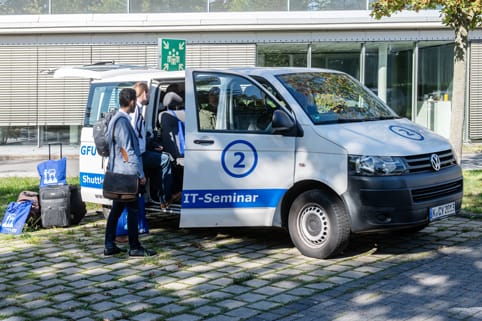Bitte wählen Sie die Bereiche, die Sie exportieren möchten:
Schulungsformen
Offene Schulung
- 2 Tage
- 4 gesicherte Termine
- 1.370,00 p. P. zzgl. MwSt.
- Köln / Online
- Online oder Präsenz
- Dritter Mitarbeitende kostenfrei
Inhouse-/Firmenschulung
- 2 Tage - anpassbar
- Termin nach Wunsch
- Preis nach Angebot
- In Ihrem Hause oder bei der GFU
- Online, Präsenz oder Hybrid
- Lernumgebung in der Cloud
Individualschulung
- 2 Tage - anpassbar
- Termin nach Wunsch
- Preis nach Angebot
- In Ihrem Hause oder bei der GFU
- Online, Präsenz oder Hybrid
- Lernumgebung in der Cloud
Beschreibung
- Early bug detection: Test automation allows developers to catch bugs and issues early in the development cycle. By writing automated tests alongside their code, developers can quickly identify and fix problems before they propagate further into the software.
- Faster feedback loops: Automated tests can be executed rapidly, providing developers with immediate feedback on their code changes. This allows for quicker identification and resolution of issues, leading to faster iterations and more efficient development.
- Code refactoring and maintenance: Test automation provides a safety net for developers when refactoring or modifying existing code. Automated tests help ensure that changes made to the codebase do not introduce regressions, providing confidence to developers as they make modifications and improvements.
- Increased code coverage: Automated tests encourage developers to write more comprehensive test cases, increasing the overall code coverage. This helps in identifying edge cases, corner cases, and potential errors, leading to more robust and reliable software.
- Regression testing: Test automation is particularly valuable for regression testing. Developers can quickly run automated regression tests to ensure that previously implemented functionalities still work correctly after new changes are made. This helps prevent the reintroduction of previously fixed bugs.
- Collaboration and communication: Automated tests serve as a clear and executable specification of the expected behavior of the code. This helps improve collaboration between developers and other team members, facilitating effective communication and reducing ambiguity about system requirements.
- Continuous integration and delivery: Test automation integrates seamlessly with continuous integration and delivery (CI/CD) pipelines. Developers can incorporate automated tests into the build process, ensuring that changes pass all tests before being merged or deployed. This promotes a more agile and streamlined development workflow.
- Confidence in code changes: Automated tests provide developers with confidence in their code changes. By having comprehensive test coverage and passing test results, developers can be assured that their modifications have not adversely affected existing functionality.
- Time savings: While there is an initial investment in writing automated tests, it ultimately saves time for developers. Automated tests can be executed repeatedly without manual intervention, freeing up developers to focus on other critical tasks.
Schulungsziel
Some key goals for developers include:
- Faster feedback: Test automation enables developers to receive rapid feedback on their code changes. Automated tests can be executed quickly, providing immediate insights into any issues or regressions introduced. This allows developers to address problems promptly and iterate more efficiently.
- Code confidence: Automated tests serve as a safety net for developers when making code modifications or refactoring. Having comprehensive test coverage ensures that changes do not break existing functionality, providing developers with confidence in their code.
- Increased productivity: Test automation reduces the time and effort spent on manual testing. Developers can focus on writing new code and implementing features, knowing that automated tests will validate the functionality. This improves productivity and allows developers to deliver software more efficiently.
- Code quality: Test automation encourages developers to write testable code and follow best practices. Automated tests can detect issues early, such as logic errors, boundary cases, or unexpected behavior. This helps developers produce cleaner, more robust code.
- Collaboration: Automated tests serve as executable specifications that facilitate communication and collaboration between developers, testers, and other team members. They provide a shared understanding of expected behavior and can act as documentation for the codebase.
- Continuous integration and delivery: Test automation integrates seamlessly with continuous integration and delivery (CI/CD) pipelines. Developers can automate the execution of tests in the build process, ensuring that changes are validated before being merged or deployed. This promotes a streamlined development workflow.
- Time savings: While there is an initial investment in creating automated tests, they save time in the long run. Developers can run automated tests repeatedly without manual intervention, freeing up time for other development tasks and reducing the time spent on manual testing.
- Faster bug detection: Automated tests help identify bugs early in the development cycle. By catching issues sooner, developers can address them before they become more complex or impact other parts of the system. This leads to faster bug resolution and overall faster development iterations.
Details
Wer teilnehmen sollte
- Software Developers: Developers who want to enhance their skills in test automation using JUnit5 and Mockito.
- Testers/QA Engineers: Testers or QA engineers looking to expand their knowledge and skills in test automation.
- Software Engineers: Engineers involved in software development, including backend, frontend, or full-stack developers.
- Technical Leads/Managers: Technical leads or managers responsible for overseeing software development projects.
- Agile Team Members: Members of Agile development teams, including Scrum Masters and Product Owners.
- Individuals interested in test automation: Anyone interested in learning about test automation and leveraging JUnit5 and Mockito.
Ihre Schulung
Präsenz-Schulung | Online-Schulung |
|---|---|
| Lernmethode | |
Ausgewogene Mischung aus Theorie und Praxis | Wie auch bei unseren Präsenz-Seminaren: Ausgewogene Mischung aus Theorie und praktischen Übungen. Trainer durchgehend präsent. |
| Unterlagen | |
Seminarunterlagen oder Fachbuch zum Seminar inklusive, das man nach Rücksprache mit dem Trainer individuell auswählen kann. | Seminarunterlagen oder Fachbuch inklusive (per Post). Das Fachbuch wählt der Trainer passend zum Seminar aus - Ihren individuellen Buch-Wunsch berücksichtigen wir auf Nachfrage gerne. |
| Arbeitsplatz | |
| PC/VMs für jeden Teilnehmenden Hochwertige und performante Hardware Große, höhenverstellbare Bildschirme Zugang zu Ihrem Firmennetz erlaubt |
|
| Lernumgebung | |
| |
| Arbeitsmaterialien | |
DIN A4 Block, Notizblock, Kugelschreiber, USB-Stick, Textmarker, Post-its | |
| Teilnahmezertifikat | |
Die Teilnahmezertifikat inkl. Inhaltsverzeichnis wird Ihnen am Ende des Seminars ausgehändigt. | Die Teilnahmezertifikat inkl. Inhaltsverzeichnis wird Ihnen per Post zugesandt. |
Organisation
Präsenz-Schulung | Online-Schulung | |
|---|---|---|
| Teilnehmendenzahl | ||
min. 1, max. 8 Personen | ||
| Garantierte Durchführung | ||
Ab 1 Teilnehmenden* | ||
| Schulungszeiten | ||
| ||
| Ort der Schulung | ||
 GFU Schulungszentrum GFU SchulungszentrumAm Grauen Stein 27 51105 Köln-Deutz oder online im Virtual Classroom oder europaweit bei Ihnen als Inhouse-Schulung Um ein optimales Raumklima zu gewährleisten, haben wir das Schulungszentrum mit 17 hochmodernen Trotec TAC V+ Luftreinigern ausgestattet. Diese innovative Filtertechnologie (H14 zertifiziert nach DIN EN1822) sorgt dafür, dass die Raumluft mehrfach pro Stunde umgewälzt wird und Schadstoffe zu 99.995% im HEPA-Filter abgeschieden und infektiöse Aerosole abgetötet werden. Zusätzlich sind alle Räume mit CO2-Ampeln ausgestattet, um jederzeit eine hervorragende Luftqualität sicherzustellen. | ||
| Räumlichkeiten | ||
Helle und modern ausgestattete Räume mit perfekter Infrastruktur | Bequem aus dem Homeoffice von überall | |
| Preisvorteil | ||
Dritter Mitarbeitende nimmt kostenfrei teil. Eventuell anfallende Prüfungskosten für den dritten Teilnehmenden werden zusätzlich berechnet. Hinweis: Um den Erfolg der Schulung zu gewährleisten, sollte auch der dritte Teilnehmende die erwarteten Vorkenntnisse mitbringen. | ||
| All-Inclusive | ||
Gebäck, Snacks und Getränke ganztägig, Mittagessen im eigenen Restaurant, täglich 6 Menüs, auch vegetarisch | Eine Auswahl unserer Frühstücks-Snacks und Nervennahrungs-Highlights senden wir Ihnen mit den Seminarunterlagen per Post zu. | |
| Barrierefreiheit | ||
Das GFU-Schulungszentrum (Am Grauen Stein 27) ist barrierefrei | - | |
Buchen ohne Risiko
| Rechnungsstellung |
Erst nach dem erfolgreichen Seminar. Keine Vorkasse. |
| Stornierung |
Kostenfrei bis zum Vortag des Seminars |
| Vormerken statt buchen |
Sichern Sie sich unverbindlich Ihren Seminarplatz schon vor der Buchung - auch wenn Sie selbst nicht berechtigt sind zu buchen |
Kostenfreie Services
Präsenz-Schulung | Online-Schulung |
|---|---|
|
|
Inhalt
- Introduction to Test Automation
- Testing Software
- Automated vs. Manual Tests
- Types of Automated Tests (Unit Test, Integration Test, Acceptance Test)
- Overview of Test Coverage Measurement
- Fundamentals of JUnit
- Overview of the JUnit Framework
- Integration of JUnit in Java Development Environment and Build Process
- Structure of Test Classes
- Controlling Test Execution with Annotations
- Result Verification with Assertions
- Testing Exceptions
- Advanced JUnit Concepts
- Parameterized Tests
- Test Suite Composition
- Test Control with Categories
- Flexible Result Verification with Matchers
- Extending JUnit Classes with Rules
- Test-Driven Development (TDD)
- Introduction to Test-Driven Development (TDD)
- Test-First Approach
- Introduction to Mocking
- Concept and Implementation of Mock Objects
- Dynamic Generation with Mocking Frameworks
- Using Mockito (alternative: EasyMock)
- Using PowerMock for Specialized Mocking Tasks
- Putting it All Together (Integration and Practice)
- Continuous Integration and Test Automation
- Mocking Dependencies in Tests
- Test Doubles (Stub, Spy, Fake) and their usage
- Integrating JUnit and Mockito in a Sample Project
- Applying Test Automation Techniques
- Hands-on Exercises and Practice
Buchungsmöglichkeiten
Online oder in Präsenz teilnehmen
Sie können sowohl Online als auch in Präsenz am Seminar teilnehmen. Klicken Sie bei Ihrer Buchung oder Anfrage einfach die entsprechende Option an.
Gesicherte offene Termine
| Termin | Ort | Preis | |
|---|---|---|---|
| 19.12.-20.12.2024 Plätze vorhanden Online 1.370,00 | Online | 1.370,00 | Buchen Vormerken |
| 20.02.-21.02.2025 Plätze vorhanden Köln / Online 1.370,00 | Köln / Online | 1.370,00 | Buchen Vormerken |
| 08.05.-09.05.2025 Plätze vorhanden Köln / Online 1.370,00 | Köln / Online | 1.370,00 | Buchen Vormerken |
| 21.08.-22.08.2025 Plätze vorhanden Köln / Online 1.370,00 | Köln / Online | 1.370,00 | Buchen Vormerken |
Inhalte werden auf Wunsch an die Anforderungen Ihres Teams angepasst.
- Online, Präsenz oder Hybrid
- Komplette Lernumgebung in der Cloud mit Remote Zugriff
Fokus aufs Fachliche und maximaler Raum für individuelle Fragen.
- Online, Präsenz oder Hybrid
- Komplette Lernumgebung in der Cloud mit Remote Zugriff
Unterstützung nach der Schulung durch
individuelle Nachbetreuung
- Alle folgenden Schulungsformen können auch Online als Virtual Classroom durchgeführt werden.
- Eine Offene Schulung findet zu einem festgelegten Zeitpunkt im voll ausgestatteten Schulungszentrum oder Online/Remote statt. Sie treffen auf Teilnehmende anderer Unternehmen und profitieren vom direkten Wissensaustausch.
- Eine Inhouse-/Firmen-Schulung geht auf die individuellen Bedürfnisse Ihres Unternehmens ein. Sie erhalten eine kostenfreie Beratung von Ihrem Seminarleiter und können Inhalte und Dauer auf Ihren Schulungsbedarf anpassen. Inhouse-Schulungen können Europaweit durchgeführt werden.
- Bei einer Individual-Schulung erhalten Sie eine 1-zu-1 Betreuung und bestimmen Inhalt, Zeit und Lerntempo. Der Dozent passt sich Ihren Wünschen und Bedürfnissen an.
Sie können unsere Schulungen auch als Remote Schulung im Virtual Classroom anfragen.
In drei Schritten zum Online Seminar im Virtual Classroom:
- Seminar auswählen und auf "Buchen" klicken
- Wählen Sie bei "Wie möchten Sie teilnehmen?" einfach "Online" aus.
- Formular ausfüllen und über den Button "Jetzt buchen" absenden.
Unser Kundenservice meldet sich bei Ihnen mit der Buchungsbestätigung.
Unsere Online Schulungen finden im Virtual Classroom statt. Ein Virtual Classroom bündelt mehrere Werkzeuge, wie Audio-Konferenz, Text-Chat, Interaktives Whiteboard, oder Application Sharing.
Vorteile von Virtual Classroom:
- Sie erhalten 1 zu 1 die gleiche Lernumgebung, die Sie auch vor Ort bei uns vorfinden
- Die technische Vorbereitung wird von den GFU-Technikern vorgenommen
- Sie erhalten remote Zugriff auf Ihren persönlichen Schulungs-PC im GFU-Seminarraum
- Die Virtual Classroom Lösung lässt sich auch im Browser betreiben
- Die GFU-Technik leistet wie gewohnt Soforthilfe bei Problemen
- Die Schulungsunterlagen bekommen Sie per Post zugeschickt
- Sie sparen Reisekosten und Zeit
- 19. Dez. - 20. Dez. ✓ Noch einige Plätze frei ▶ Köln + Online/Remote
- 20. Feb. - 21. Feb. ✓ Noch einige Plätze frei ▶ Köln + Online/Remote
- 08. Mai - 09. Mai ✓ Noch einige Plätze frei ▶ Köln + Online/Remote
- 21. Aug. - 22. Aug. ✓ Noch einige Plätze frei ▶ Köln + Online/Remote
- Auch als Inhouse-Schulung, bundesweit mit Termin nach Wunsch und individuellen Inhalten
- Buchen ohne Risiko! Kostenfreie Stornierung bis zum Vortag des Seminars
Buchen Sie diese kostenfreien Serviceleistungen für Präsenzseminare ganz einfach während des Buchungsprozesses dazu!

Machen Sie sich keinen Kopf um die Anreise! Unser Shuttle fährt Sie. Oder Sie parken einfach auf einem extra für Sie reservierten Parkplatz.

Hotelzimmer gesucht? Wir organisieren Ihnen eins. Ihr Vorteil: Sie sparen Zeit und Geld!

Gesund oder lecker? Warum nicht beides? Freuen Sie sich auf unsere kulinarische Verpflegung!

Parkplätze sind in ausreichender Zahl vorhanden. Reisen Sie mit dem Auto an, reservieren wir Ihnen einen Parkplatz.